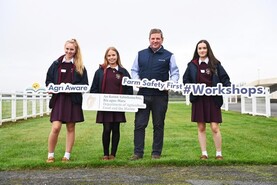Safety should always be kept in mind when completing any task on farm.
But there are some points in the year when multiple jobs need completing, or when handling of stock becomes more frequent.
During such periods, the risk of injury to people and animals increases. Outlined are five areas to keep safety in mind this autumn.
1. Slurry
Working with slurry is always hazardous, whether it be the gases released when mixing, opening tanks, filling the tanker or spreading on the land.
With the closed period fast approaching, the pressure is on to get tanks emptied. When mixing tanks, exit the shed once the pump is engaged. This is when slurry gases are at their most potent.
Keep children and farm pets away from sheds. Ensure openings to mixing points have a safety cover in place, especially when leaving the yard to empty the tanker.
PTO guards should be in place on the mixing pump and tanker. Tankers should have lights and brakes in working order.
Make sure the tractor pulling the tanker has enough horsepower and can brake safely under full-load on the road. Front weights on the tractor will improve weight transfer when pulling a full tanker.
2. Autumn calving
With autumn calving moving into full swing, be careful around freshly calved cows. Take extra care with cows that calved outside when approaching their calves for tagging.
Cows can be quiet for 51 weeks of the year. But those same animals can become temperamental around calving. Never assume animals will behave as normal.
3. Removing the stock bull
In spring calving herds, there will be some farmers removing stock bulls at this time of year. Bulls can become aggressive when removed from cows and isolated.
To reduce aggression levels, pull out one or two cows that are settled in calf. Pen or graze with the bull to keep him calm.
Thin cows that need some extra feed are ideal.
4. Grazing yearling bulls
In autumn calving herds where male animals will be finished as bulls in late autumn, yearling animals will be temperamental at this time of year.
If yearling bulls are still at grass, be cautious when herding animals or offering meal in troughs. These animals are better off housed, reducing the risks associated with feeding meals.
5. Weaning spring-born calves
Weaning is another time when risks associated with handling animals increases. Removing calves from a dam will trigger the protective instinct in cows.
Make sure cows are securely penned during the weaning process. In handling pens, the operator should have a safe working space and two escape points from group pens in case cows do become aggressive.
Keep calves out of sight and smell from their dams until animals have settled post weaning.
Read more
Beef Trends: kill continues to fall
Top 10 suckler herd sires revealed for spring-summer 2023
Safety should always be kept in mind when completing any task on farm.
But there are some points in the year when multiple jobs need completing, or when handling of stock becomes more frequent.
During such periods, the risk of injury to people and animals increases. Outlined are five areas to keep safety in mind this autumn.
1. Slurry
Working with slurry is always hazardous, whether it be the gases released when mixing, opening tanks, filling the tanker or spreading on the land.
With the closed period fast approaching, the pressure is on to get tanks emptied. When mixing tanks, exit the shed once the pump is engaged. This is when slurry gases are at their most potent.
Keep children and farm pets away from sheds. Ensure openings to mixing points have a safety cover in place, especially when leaving the yard to empty the tanker.
PTO guards should be in place on the mixing pump and tanker. Tankers should have lights and brakes in working order.
Make sure the tractor pulling the tanker has enough horsepower and can brake safely under full-load on the road. Front weights on the tractor will improve weight transfer when pulling a full tanker.
2. Autumn calving
With autumn calving moving into full swing, be careful around freshly calved cows. Take extra care with cows that calved outside when approaching their calves for tagging.
Cows can be quiet for 51 weeks of the year. But those same animals can become temperamental around calving. Never assume animals will behave as normal.
3. Removing the stock bull
In spring calving herds, there will be some farmers removing stock bulls at this time of year. Bulls can become aggressive when removed from cows and isolated.
To reduce aggression levels, pull out one or two cows that are settled in calf. Pen or graze with the bull to keep him calm.
Thin cows that need some extra feed are ideal.
4. Grazing yearling bulls
In autumn calving herds where male animals will be finished as bulls in late autumn, yearling animals will be temperamental at this time of year.
If yearling bulls are still at grass, be cautious when herding animals or offering meal in troughs. These animals are better off housed, reducing the risks associated with feeding meals.
5. Weaning spring-born calves
Weaning is another time when risks associated with handling animals increases. Removing calves from a dam will trigger the protective instinct in cows.
Make sure cows are securely penned during the weaning process. In handling pens, the operator should have a safe working space and two escape points from group pens in case cows do become aggressive.
Keep calves out of sight and smell from their dams until animals have settled post weaning.
Read more
Beef Trends: kill continues to fall
Top 10 suckler herd sires revealed for spring-summer 2023






 This is a subscriber-only article
This is a subscriber-only article










SHARING OPTIONS: